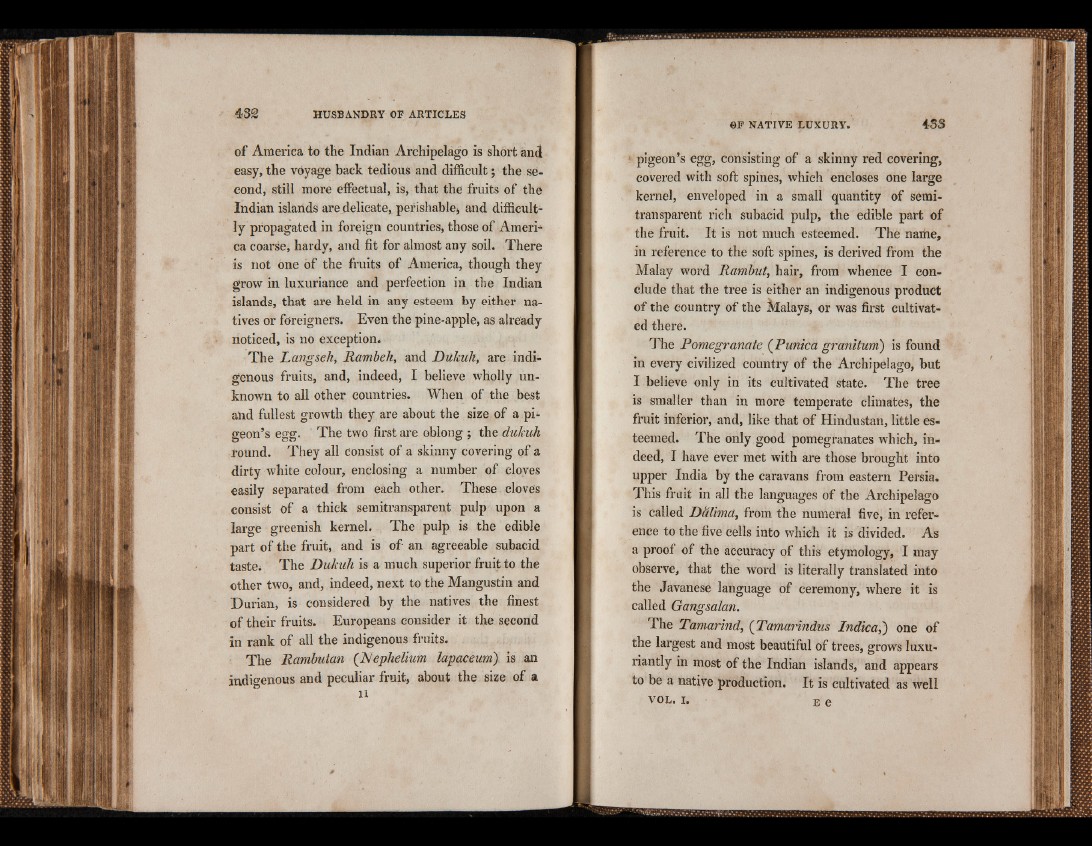
of America to the Indian Archipelago is short and
easy, the voyage back tedious and difficult; the second,
still more effectual, is, that the fruits of the
Indian islands areilelicate, perishable* and difficultly
propagated in foreign countries, those of America
coarse, hardy, and fit for almost any soil. There
is not one of the fruits of America, though they
grow in luxuriance and perfection in the Indian
islands, that are held in any esteem by either natives
or foreigners. Even the pine-apple, as already
noticed, is no exception.
The Langseh, Rambeh, and Dukuh, are indigenous
fruits, and, indeed, I believe wholly unknown
to all other countries. When of the best
and fullest growth they are about the size of a pigeon’s
egg. The two first are oblong ; the dukuh
round. They all Consist of a skinny covering of a
dirty white colour, enclosing a number of cloves
easily separated from each other. These cloves
consist of a thick semitransparent pulp upon a
large greenish kernel. The pulp is the edible
part of the fruit, and is of an agreeable subacid
taste. The Dukuh is a much superior fruit to the
other two, and, indeed, next to the Mangustin and
Durian, is considered by the natives the finest
of their fruits. Europeans consider it the second
in rank of all the indigenous fruits.
The Rambutan (Nephelium lapaceum) is an
indigenous and peculiar fruit, about the size of a
11
■ pigeon’s egg, consisting of a skinny red covering,
covered with soft spines, which encloses one large
kernel, enveloped in a small quantity of semitransparent
rich subacid pulp, the edible part of
the fruit. It is not much esteemed. The name,
in reference to the soft spines, is derived from the
Malay word Rambut, hair, from whence I conclude
that the tree is either an indigenous product
of the country of the Malays, or was first cultivated
there.
The Pomegranate (Punica granitum) is found
in every civilized country of the Archipelago, but
I believe only in its cultivated state. The tree
is smaller than in more temperate climates, the
fruit inferior, and, like that of Hindustan, little esteemed.
The only good pomegranates which, indeed,
I have ever met with are those brought into
upper India by the caravans from eastern Persia.
This fruit in all the languages of the Archipelago
is called Dalimct, from the numeral five, in reference
to the five cells into which it is divided. As
a proof of the accuracy of this etymology, I may
observe, that the word is literally translated into
the Javanese language of ceremony, where it is
called Gangsalan.
The Tamarind, ( Tamarindus Indica,) one of
the largest and most beautiful of trees, grows luxuriantly
in most of the Indian islands, and appears
to be a native production. It is cultivated as well
V OL . i . e e